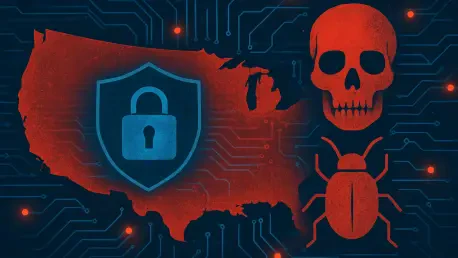In a digital landscape where cyber threats loom larger than ever, the United States finds itself grappling with a startling gap in its defenses, as key cybersecurity laws and programs have expired, leaving national security hanging in the balance. The lapse of the Cybersecurity Information Sharing Act (CISA 2015), alongside the termination of the State and Local Cybersecurity Grant Program, has stripped away critical protections and resources at a time when cyberattacks are becoming more sophisticated and frequent. Compounding this crisis, a partial government shutdown has drastically reduced staffing at the Cybersecurity and Infrastructure Security Agency (CISA), slashing its workforce from over 2,500 to fewer than 900 employees. This convergence of lapsed legislation, diminished funding, and understaffed agencies has created a perfect storm of vulnerability, threatening not just economic stability but the safety of essential services across the nation. Lawmakers, experts, and industry leaders are sounding the alarm, yet solutions remain frustratingly out of reach.
The implications of these failures are far-reaching, touching every level of society from federal agencies to local communities, and highlighting the urgent need for robust cybersecurity measures. Without the legal safeguards of CISA 2015, private companies are increasingly hesitant to share vital cyber-threat data, potentially leaving blind spots in the collective defense against digital attacks. State and local governments, stripped of crucial grant funding, struggle to protect infrastructure like hospitals and schools, making them easy targets for ransomware. Meanwhile, the federal government’s reduced capacity to respond to major incidents raises the specter of a catastrophic breach with no adequate response in place. Despite bipartisan recognition of the urgency, political gridlock continues to stall progress, leaving the nation in a precarious limbo as threats evolve daily.
Legislative Failures and Political Gridlock
Stalled Reauthorization Efforts
The heart of the current cybersecurity crisis lies in Congress, where, despite widespread bipartisan support, efforts to reauthorize CISA 2015 and related programs remain frustratingly stagnant. Bills have been introduced in both the Senate and the House to extend these critical laws for up to a decade, aiming to provide long-term stability for cybersecurity collaboration. However, individual objections, often from a single senator, have repeatedly blocked unanimous consent requests, halting swift legislative action. This gridlock reveals a troubling fragility in the system, where even measures deemed essential for national security can be derailed by procedural hurdles. The urgency to resolve this stalemate is palpable, as each day of inaction widens the window of vulnerability for the nation, exposing it to increasingly sophisticated cyber threats that do not wait for political consensus.
Beyond procedural delays, the lack of a clear legislative vehicle exacerbates the problem, with temporary continuing resolutions offering only short-lived band-aids rather than robust solutions. Lawmakers from both parties have expressed frustration over the inability to prioritize these reauthorizations amidst other legislative agendas. The risk here is not just theoretical—experts warn that prolonged delays could embolden malicious actors to exploit gaps in defenses, knowing that legal and operational frameworks are in disarray. As discussions drag on, the absence of a unified strategy to push these bills forward continues to undermine confidence in the government’s ability to protect against digital threats, leaving stakeholders anxiously awaiting a breakthrough that seems perpetually out of reach.
Misunderstandings and Partisan Tensions
Adding another layer of complexity to the legislative standstill are misunderstandings and partisan tensions that cloud the discourse around cybersecurity laws. A notable point of confusion arises between CISA 2015, the specific law facilitating information sharing, and the CISA agency itself, which has faced criticism from some political factions for unrelated issues like alleged overreach in other domains. This conflation has muddied the waters, with critics inadvertently stalling reauthorization efforts over misplaced grievances. Such missteps highlight how easily technical policy debates can be derailed by broader ideological disagreements, even when the stakes involve critical national security infrastructure that demands clarity and focus.
Moreover, partisan friction, though not the dominant force in this debate, still plays a disruptive role as differing priorities among lawmakers slow down consensus-building. While both Democrats and Republicans largely agree on the need to restore these protections, peripheral disputes over the scope of government involvement in cybersecurity or agency oversight create unnecessary roadblocks. This dynamic reflects a broader trend of legislative dysfunction, where even urgent, widely supported measures can become entangled in political posturing. The result is a frustrating delay in addressing a crisis that transcends party lines, with the potential to compromise the nation’s ability to fend off digital adversaries who exploit every moment of hesitation.
Impacts on Private Sector Collaboration
Loss of Liability Protections
One of the most immediate consequences of the lapse in CISA 2015 is the erosion of liability protections that once encouraged private companies to share cyber-threat information with the government and among themselves. These safeguards, which included exemptions from antitrust laws and protections against public disclosure under the Freedom of Information Act, were designed to foster trust and collaboration in identifying and mitigating digital risks. Without them, businesses face heightened legal risks when sharing sensitive data, prompting a growing wariness that could fracture the collective defense framework. This hesitation is not just a minor setback—it threatens to create significant gaps in the nation’s ability to detect and respond to cyber threats before they escalate into full-blown crises.
The private sector’s role in cybersecurity is indispensable, as companies often possess frontline insights into emerging threats that government agencies rely on to build broader strategies. However, the absence of legal assurances has introduced a chilling effect, with firms now weighing the potential repercussions of data sharing against the benefits. Industry leaders have noted early signs of reluctance among smaller enterprises, which lack the legal resources to navigate these uncertainties. If this trend continues, the loss of shared intelligence could blindside both public and private entities to evolving attack vectors, undermining years of progress in building a unified front against cybercriminals who thrive on such divisions.
Potential for Diminished Threat Intelligence
While the full impact of diminished information sharing has yet to materialize, the potential for a significant decline in threat intelligence looms large over the cybersecurity landscape. Industry experts caution that without the legal backbone of CISA 2015, companies may choose to withhold critical data about vulnerabilities, fearing exposure to lawsuits or competitive disadvantages. This shift could severely hamper the government’s ability to piece together a comprehensive picture of cyber threats, as private sector input often serves as an early warning system for attacks that might otherwise go undetected. The ripple effects of such a breakdown in collaboration could leave entire sectors exposed to risks that might have been mitigated through timely shared insights.
Furthermore, the loss of robust threat intelligence sharing could disproportionately affect smaller businesses and critical industries that rely on collective data to bolster their defenses. Large corporations might have the resources to weather this uncertainty, but many smaller entities could find themselves isolated, unable to access the broader intelligence networks that once helped level the playing field. This growing disparity risks creating a fragmented cybersecurity ecosystem, where only the well-resourced survive while others fall prey to increasingly targeted attacks. As the situation unfolds, the urgency to restore legal protections becomes even clearer, lest the nation lose a vital tool in its fight against digital adversaries.
Vulnerability at State and Local Levels
Funding Cuts to Critical Infrastructure
The expiration of the State and Local Cybersecurity Grant Program has dealt a severe blow to the ability of municipal and state governments to safeguard critical infrastructure, leaving them dangerously exposed to cyber threats. This program provided essential funding to secure systems that underpin vital services such as hospitals, schools, and water utilities—sectors that are often prime targets for ransomware and other malicious attacks. Without these resources, local entities, many of which already operate on tight budgets, struggle to implement even basic cybersecurity measures, making them easy targets for attackers. The absence of this financial lifeline has created a stark vulnerability at the community level, where the consequences of a breach can directly impact public safety and daily life.
Experts have underscored the urgency of this threat, noting that state and local governments often lack the in-house expertise and funding to counter sophisticated cyberattacks on their own. The loss of grants means delayed upgrades to outdated systems, insufficient training for staff, and limited access to threat detection tools—all of which are essential to maintaining resilience. As cybercriminals increasingly target these under-resourced entities, the potential for widespread disruption grows, with a single successful attack capable of paralyzing entire communities. Restoring this funding is not just a matter of policy but a critical step in protecting the foundational services that citizens rely on every day.
Risks to Public Safety and Services
Beyond the financial constraints, the risks to public safety and essential services posed by underfunded cybersecurity at the local level are profoundly alarming, as unprotected systems in schools could lead to closures or data breaches that compromise student safety. Vulnerabilities in hospital networks might disrupt life-saving medical care during critical moments, while water systems face the threat of tampering that could endanger entire populations, as seen in past incidents where hackers gained access to utility controls. These scenarios are not mere hypotheticals but pressing concerns that highlight the cascading effects of a single cyberattack on community well-being, amplifying the urgency to address this funding gap.
The broader societal impact of such disruptions cannot be overstated, as they erode public trust in government institutions tasked with ensuring safety and continuity. A ransomware attack that shuts down a city’s emergency response systems, for instance, could delay critical interventions, with potentially tragic outcomes. Cybersecurity professionals emphasize that local governments, often the first line of defense for citizens, are now among the most vulnerable due to these cuts. The need for immediate action to reinstate grant programs is clear, as every day without adequate protection increases the likelihood of a devastating incident that could reshape public perception of governmental efficacy in the digital age.
Federal Readiness in Crisis
Staffing Shortages at CISA
A partial government shutdown has precipitated a dire situation at the Cybersecurity and Infrastructure Security Agency (CISA), where staffing levels have plummeted from over 2,500 to fewer than 900 employees, severely undermining federal readiness for cyber crises. This drastic reduction means that the agency, tasked with coordinating national responses to digital threats, operates with a skeleton crew at a time when attacks are growing in both frequency and complexity. Essential functions, from threat analysis to incident response planning, are stretched thin, leaving little capacity to handle a large-scale breach. This staffing crisis is not a minor administrative issue but a fundamental threat to the nation’s ability to defend against adversaries who exploit such weaknesses with precision.
The implications of these shortages are particularly troubling given the current threat landscape, where state-sponsored actors and criminal groups continuously probe for gaps in defenses. With fewer personnel to monitor alerts, coordinate with private entities, or develop countermeasures, CISA’s effectiveness is critically impaired. Lawmakers have voiced deep concern over this diminished capacity, warning that a major incident during this period could overwhelm the agency’s resources entirely. Addressing this staffing crisis demands not only an end to the shutdown but also a strategic effort to ensure that such vulnerabilities are not repeated in future budgetary disputes, lest the nation pay a steep price for unpreparedness.
Implications for National Security
The broader implications of CISA’s reduced capacity cast a long shadow over national security, with experts and officials alike highlighting the catastrophic potential of a major cyberattack during this period of weakness. A large-scale breach, whether targeting critical infrastructure or government systems, could exploit the agency’s limited ability to mount a coordinated response, resulting in widespread economic and societal damage. The absence of sufficient personnel to liaise with state, local, and private partners further compounds the risk, as seamless communication is vital during a crisis. This situation underscores a glaring gap in the nation’s cybersecurity posture, where even temporary lapses in readiness can invite exploitation by adversaries.
Moreover, the national security stakes extend beyond immediate response capabilities to the long-term erosion of trust in federal institutions tasked with safeguarding the digital domain. If a significant attack occurs and the response falters due to staffing shortages, the fallout could embolden hostile actors to launch further assaults, perceiving a lack of resolve or capacity. Cybersecurity professionals stress that rebuilding CISA’s workforce is not just about numbers but about restoring a robust framework for deterrence and resilience. The urgency to resolve this crisis is paramount, as the consequences of inaction could reverberate for years, reshaping the geopolitical landscape in favor of those who seek to undermine stability through digital means.
Calls for Modernization and Long-Term Solutions
Updating Cybersecurity Frameworks
As the nation grapples with the immediate fallout of lapsed laws, a growing chorus of voices advocates for more than just reauthorization—there is a pressing need to modernize CISA 2015 to address the evolving nature of cyber threats that have emerged over the years. Experts propose expanding the law’s definitions to encompass emerging risks such as supply chain vulnerabilities and attacks driven by artificial intelligence, which were not fully anticipated when the legislation was first enacted. Additionally, introducing new incentives for companies to share data on systemic weaknesses could bolster collective defenses against threats that transcend individual organizations. Such updates are seen as essential to ensure that cybersecurity frameworks remain relevant in a rapidly changing digital environment.
The push for modernization also includes calls to streamline processes for real-time threat communication, ensuring that critical information flows seamlessly between public and private sectors. Industry leaders argue that without adapting to contemporary challenges, reauthorized laws risk becoming outdated shortly after implementation, necessitating further revisions. This forward-looking approach, while ambitious, faces hurdles in gaining consensus on the specifics of these updates, as lawmakers balance innovation with feasibility. Nevertheless, the dialogue around modernization signals a recognition that simply restoring past measures is insufficient—proactive adaptation is key to staying ahead of adversaries in the cyber realm.
Balancing Immediate Action with Strategic Planning
While the urgency for immediate action to restore lapsed cybersecurity protections is undeniable, stakeholders emphasize the importance of balancing short-term fixes with strategic, long-term planning to ensure robust digital security. Temporary extensions through continuing resolutions provide fleeting relief but fail to offer the stability needed for sustained defense against digital threats. Proposals for a decade-long reauthorization of CISA 2015 aim to address this by creating a predictable framework that companies, governments, and agencies can rely on without the constant threat of expiration. This long-term certainty is critical for fostering trust and investment in cybersecurity initiatives across all sectors.
At the same time, strategic planning must incorporate lessons learned from the current crisis to prevent future lapses, such as embedding safeguards against staffing disruptions during government shutdowns. Cybersecurity professionals advocate for a dual approach—swift legislative action to reinstate protections now, paired with comprehensive reforms to address systemic weaknesses over time. This balance is not without challenges, as political and budgetary constraints often prioritize immediate needs over visionary policies. Yet, the consensus remains clear: only through a combination of rapid response and deliberate foresight can the nation hope to close the gaps in its cybersecurity armor and build resilience for the threats of tomorrow.
Pathways to a Secure Digital Future
Reflecting on the challenges faced, it became evident that the expiration of pivotal cybersecurity laws and programs had exposed significant vulnerabilities across multiple levels of American society, putting national and economic security at risk. The lapse of CISA 2015 and critical grant funding, coupled with severe staffing reductions at the CISA agency, had created a precarious situation. Political gridlock and misunderstandings had further delayed essential reauthorizations, while the private sector, state governments, and federal agencies grappled with diminished collaboration and readiness. These past struggles highlighted a systemic failure to prioritize and adapt cybersecurity measures in the face of evolving digital threats, leaving the nation on unsteady ground.
Looking ahead, actionable steps must focus on swift legislative resolution to reinstate and extend key protections, ideally for a decade, to provide much-needed stability in the face of evolving digital threats. Modernizing existing frameworks to address new risks, such as AI-driven attacks, should be a parallel priority, ensuring defenses evolve with the threat landscape. Additionally, securing consistent funding and staffing for cybersecurity initiatives will be crucial to prevent future crises during political or budgetary disputes. Engaging private and public stakeholders in a unified strategy offers the best chance to rebuild trust and resilience, paving the way for a fortified digital future where such vulnerabilities are no longer a looming threat but a challenge met with preparedness and innovation.









